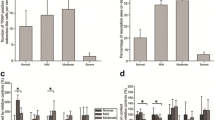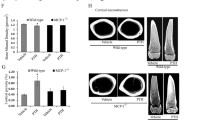Abstract
The pathogenesis of idiopathic hypercalciuria (IH) has not been elucidated yet, but a correlation between IH and altered bone metabolism has been proposed. Since nitric oxide (NO) regulates osteoclasts’ bone resorption, a possible role for NO can be suggested. In this study we evaluated iNOS gene expression by reverse transcription of mRNA from monocytes, followed by polymerase chain reaction in patients with IH subdivided into fasting (FH) and absorptive (AH) hypercalciuria. Since superoxide (O −2 ), which metabolizes NO, is overproducted by osteoclasts during bone resorption, peroxynitrite plasma level was evaluated as index of O −2 . Vertebral BMD in IH as a whole group was lower vs controls (C) (Z score=-1.78±0.2 vs 0.51±0.25, p<0.001), but only FH patients showed a reduced bone density (2.13±0.18 vs 0.51±0.25, p<0.0001). PTH and calcitriol were not different. FH showed an increase in b-ALP vs AH and C (41.1±2.6 vs 30.1±3.9 vs 26.6±3.6 U/l p<0.02), and higher uHP, either on NCD (17.7±1.6 vs 11.4±1.3 mg/g uCr, p<0.04) or after LCD (26.7±2.5 vs 16.7±1.9, p<0.01). Cells from FH patients, but not from both AH patients and C, expressed iNOS. Peroxynitrite plasma level was elevated in FH (0.30±0.07) μmol/l while not detectable in AH and C. This study confirms an altered bone metabolism only in FH which shows an abnormal NO system. The increased iNOS gene expression in FH, in fact, points toward an altered NO system’s activity downstream the generation of NO. A possible interaction of NO with O −2 , which breaks down NO, and the role of this interaction in the pathophysiology of IH is discussed.
Similar content being viewed by others
References
Pak C.Y.C., Britton F., Peterson R., Ward D., Northcutt C., Breslau N.A., McGuire J., Sakhaee K., Bush S., Nicar M., Norman D.A., Peters P. Ambulatory evaluation of nephrolithiasis. Classification, clinical presentation and diagnostic criteria. Am. J. Med. 1980, 69: 19–30.
Coe F.L., Favus M.J. Disorders of stone formation. In: Brenner B.M., Rector F.C. Jr. (Eds.), The Kidney, ed. 2. W.B. Saunders, Philadelphia, 1982, 1981, p. 1950.
Giannini S., Nobile M., Castrignano R., Pati T., Tasca A., Villi G., Pellegrini F., D’Angelo A. Possible link between vitamin D and hyperoxaluria in patients with renal stone disease. Clin. Sci. 1993, 84: 51–54.
Burckhardt P., Jaeger P. Secondary hyperparathyroidism in idiopathic renal hypercalciuria: fact or theory. J. Clin. Endocrinol. Metab. 1981, 3: 550–555.
Pacifici R., Rothstein M., Rifas L., Lan K.H., Baylink D.J., Avioli L.V., Hruska U. Increased monocyte interleukin-1 activity and decreased vertebral bone density in patients with fasting idiopathic hypercalciuria. J. Clin. Endocrinol. Metab. 1990, 71: 138–145.
Messa P., Mioni G., Franzon R., Messa M., Cruciatti A., Giannini S., D’Angelo A. Factors affecting fasting urinary calcium excretion in stone former patients on different dietary calcium intake. Scanning Microsc. 1992, 6: 239–246.
Giannini S., Nobile M., Sartori L., CaIò L., Tasca A., Dalle Carbonare L., Ciuffreda M., D’Angelo A., Pagano F., Crepaldi G. Bone density and skeletal metabolism are altered in idiopathic hypercalciuria. Clin. Nephrol. 1998, 50: 94–100.
Maclntyre J., Zaidi M., Towhibdul A., Datta H., Moonga B., Lidsbury P., Hecker M., Vane J. Osteoclastic inhibition: an action of nitric oxide not mediated by cGMP. Proc. Natl. Acad. Sci. USA 1991, 88: 2936–2941.
Collin-Osdoby P., Nickols G.A., Osdoby P. Bone cell function, regulation and communication: a role for nitric oxide. J. Cell. Biochem. 1995, 57: 399–408.
van’t Hof R.J., Ralston S.H. Cytokine-induced nitric oxide inhibits bone resorption by inducing apoptosis of osteoclast progenitors and suppressing osteoclast activity. J. Bone Min. Res. 1997, 11: 1797–1804.
Gay C. Osteoclast ultrastructure and enzyme histochemistry. Functional implications. In: Rifkin B., Gay C. (Eds.), Biology and physiology of the osteoclast. CRC Press, Boca Raton, 1992, p. 130.
Horton M.A., Helfrich M.H. Antigenic markers of osteoclasts. In: Rifkin B., Gay C. (Eds.), Biology and physiology of the osteoclast. CRC Press, Boca Raton, 1992, p. 34.
Reiling N., Ulmer A.J., Duchrow M., Ernst M., Flad H.D., Hauschildt S. Nitric oxide synthase: mRNA expression of different isoforms in human monocytes/macrophages. Eur. J. Immunol. 1994, 24: 1941–1944.
Rosalki S.B., Foo A.Y. Two new methods for separating and quantifying bone and liver alkaline phosphatase isoenzymes in plasma. Clin. Chem. 1984, 3: 1182–1186.
CaIò L., Davis P.A., Rigotti P., Milani M., Cantaro S., Marchini F., D’Angelo A., Antonello A. ecNOS overexpression in CsA treated renal transplant patients. Transpl. Proc. 1998, 30: 2012–2013.
CaIò L., Davis P.A., Milani M., Cantaro S., Antonello A., Favaro S., D’Angelo A. Increased endothelial nitric oxide synthase mRNA level in Bartter’s and Gitelman’s syndrome. Relationship to vascular reactivity. Clin. Nephrol. 1999, 1: 10–17.
Kaur H., Halliwell B. Evidence for nitric oxide-mediated oxidative damage in chronic inflammation. Nitrotyrosine in serum and synovial fluid from rheumatoid patients. FEBS Lett. 1994, 350: 9–12.
Borghi L., Meschi T., Guerra A., Maninetti L., Pedrazzoni M., Marcato A., Vescovi P., Novarini A. Vertebral mineral content in diet-dependent and dietindependent hypercalciuria. J. Urol. 1991, 146: 1334–1338.
Weisinger J.R., Alonzo E., Bellorin-Font E., Blasinc A.M., Rodriguez M.A., Paz-Martinez V., Martinis R. Possible role of cytokines on the bone mineral loss in idiopathic hypercalciuria. Kidney Int. 1996, 49: 244–250.
Ralston S.H., Ho L.P., Helfrich M., Grabowski P.S., Johnston P.W., Benjamin N. Nitric oxide: a cytokine induced regulator of bone resorption. J. Bone Miner. Res. 1995, 10: 1040–1049.
Greenwald R.A, Refkin B.R. Reactive oxygen species as potential mediators of osteoclast function. In: Rifkin B., Gay C. (Eds.), Biology and physiology of the osteoclast. CRC Press, Boca Raton, 1992, p. 316.
Ralston S.H., Grabowski P.S. Mechanisms of cytokine induced bone resorption: role of nitric oxide, cyclic guanosine monophosphate, and prostaglandins. Bone 1996, 19: 29–33.
Raisz L.G., Martin T.J. Prostaglandins in bone and mineral metabolism. In: Peck W.A. (Ed.), Bone and Mineral Research Annual. Excerpta Medica, Amsterdam, 1984, vol. 2, p. 286.
Roche C.H., Rodriguez-Iturbe B., Herrera J., Parra G. The influence of prostaglandins on urinary calcium excretion in idiopathic urolithiasis. J. Urol. 1988, 122: 421–426.
CaIò L., Cantaro S., Marchini F., Giannini S., Castrignano R., Gambaro G., Antonello A., Baggio B., D’Angelo A., Williams H., Borsatti A. Is hydrochlorothiazide-induced hypocalciuria due to inhibition of prostaglandin E2 synthesis? Clin. Sci 1990, 78: 321–325.
Author information
Authors and Affiliations
Corresponding author
Rights and permissions
About this article
Cite this article
Calò, L., Giannini, S., Bonvicini, P. et al. Idiopathic hypercalciuria: O −2 NO relationship and altered bone metabolism. J Endocrinol Invest 23, 78–83 (2000). https://doi.org/10.1007/BF03343683
Accepted:
Published:
Issue Date:
DOI: https://doi.org/10.1007/BF03343683




